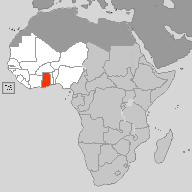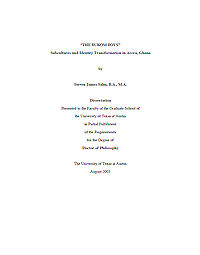| Bénin | Burkina Faso | Cabo Verde | Côte d’Ivoire | Gambia | Ghana | Guiné-Bissau | Guinée | Liberia | Mali | Mauritanie | Niger | Nigeria | Sénégal | Sierra Leone | Togo |
> Ghana | Books | Dissertations | Articles |

Also see / Voir aussi / Veja também “West Africa general – Books”
Amoah-Ramey, Nana Abena:
Female Highlife Performers.
Expression, Resistance, and Advocacy.
Lanham, Md.: Rowman & Littlefield/Lexington Books, 2018.
xvii & 171 p.
Contents
Aniagolu, Charles:
Osibisa.
Living in the State of Happy Vibes and Criss Cross Rhythms.
Victoria, B.C.: Trafford Publishing, 2004. 208 p.
Contents
Bame, Kwabena N.:
Come to Laugh. A Study of African Traditional Theatre in Ghana.
Legon: Institute of African Studies, University of Ghana, 1981. 102 p.
Second revised edition
Come to Laugh. African Traditional Theatre in Ghana.
New York, N.Y.: Lilian Barber Press, 1985. 190 p.
Contents
Coester, Markus:
Ghana Muntie.
Recordings from the G.B.C Gramophone Library & Radio Ghana 1947 to 1962.
Frankfurt: Popular African Music PAMCWM 602 & 603, 2012. 43 p. & 2 audio CDs.
Cole, Catherine M.:
Ghana’s Concert Party Theatre.
Bloomigton, Ind.: Indiana University Press, 2001. 196 p.
Contents
Collins, [Edmund] John:
E.T. Mensah. The King of Highlife.
London: Off the Record Press, 1986. 51 p.
Contents
Second edition
Accra: Anamsesem Publications,1996. 60 p.
Contents
Collins, [Edmund] John & Flemming Harrev:
King of the Black Beat.
The Story of King Bruce and the Black Beats, Highlife Dance-Band of Ghana.
Unpublished manuscript, 1991. 96 p.
Contents – PDF Download / Télécharger / Baixar 9.35 MB
Collins, [Edmund] John
‘Classic’ Highlife Tunes:
Scores of Almost One Hundred Dance Band and Guitar Band Highlife Songs.
Accra: Public Affairs Section of the US Embassy, 2005.
Collins, [Edmund] John:
E.T. Mensah & The Tempos – King of Highlife Anthology.
RetroAfric RETRO 24CD, 2015. 64 p. & 4 audio CDs.
Edmonds, E. Obeng-Amoako:
Six Strings and a Note.
Legendary Guitarist Agya Koo Nimo in his Own Words.
Houston, Tex.: Ink City Press, 2016. 315 p.
Contents
Feld, Steven:
Jazz Cosmopolitanism in Accra. Five Musical Years in Ghana.
Durham, N.C.: Duke University Press, 2012. 311 p.
Contents
KPMG:
A Comprehensive Study of the Music Sector in Ghana. Final Report.
Accra: KPMG Ghana, 2014. 290 p.
Contents – PDF Download / Télécharger / Baixar 5.98 MB
Matczynski, William:
Highlife and its Roots: Negotiating the Social, Cultural,
and Musical Continuities Between Popular and Traditional Music in Ghana.
Macalester College (Saint Paul, Minn,), Music Honors Projects. Paper 10, 2011. 67 p.
Contents – PDF Download / Télécharger / Baixar 1.41 MB
Mazzoleni, Florent; Kwesi Owusu & Markus Coester:
Ghana Highlife Music.
Bègles: Le Castor Astral, 2012. 175 p.
Table des matières / Contents
Nimo, Ko:
Ashanti Ballads. In Asante-Twi. Set in English verse by J. L. Latham.
Kumasi: Published by the authors, 1969. 22 p.
Reprint
Glasgow: Latham Services, 1988. 22 p.
Contents
Nyame, E. K.:
E. K.’s Band Song Book.
Accra: H. Teymani, 1955. 36 p.
Osumare, Halifu:
The Hiplife in Ghana. West African Indigenization of Hip-Hop.
New York, N.Y.: Palgrave Macmillan Ltd., 2012. xii & 219 p.
Contents
Plageman, Nate:
Highlife Saturday Night. Popular Music and Social Change in Urban Ghana.
Bloomington, Ind.: Indiana University Press, 2013. 318 p.
Contents
Sackey, Chrys Kwesi:
Konkoma. Eine Musikform der Fanti-Jungfischer in
den 40er und 50er Jahren (Ghana, Westafrika).
Mainzer Ethnologische Arbeiten, Band 8.
Berlin: Dietrich Reimer Verlag, 1989. 180 p.
Inhalt
Sackey, Chrys Kwesi:
Highlife. Entwicklung und Stilformen ghanaischer Gegenwartsmusik.
Mainzer Beiträge zur Afrika-Forschung, Band 3. Münster: Litt Verlag, 1996. 522 p.
Inhalt
Shipley, Jesse Weaver:
Living the Hiplife. Celebrity and Entrepreneurship in Ghanaian Popular Music.
Durham, N.C.: Duke University Press, 2013. 329 p.
Contents
Sutherland, Efua:
The Original Bob. The Story of Bob Johnson Ghana’s Ace Comedian.
Accra: Anowou Educational Publications, 1970. 25 p.
Contents
Warren, Guy:
I Have a Story to Tell…
Accra: Guinea Press, 1962. 205 p.
Younge, Pascal Yao:
Music and Dance Traditions of Ghana. History, Performance and Teaching.
Jefferson, N.C.: McFarland & Company Inc., Publishers, 2011. 448 p.
Contents
Page created 04/08/2017 © afrobib.com – update 01/02/2020

 CONTENTS
CONTENTS CONTENTS
CONTENTS CONTENTS
CONTENTS CONTENTS
CONTENTS CONTENTS
CONTENTS CONTENTS
CONTENTS CONTENTS
CONTENTS CONTENTS
CONTENTS CONTENTS
CONTENTS CONTENTS
CONTENTS CONTENTS
CONTENTS TABLE DES MATIÈRES / CONTENTS
TABLE DES MATIÈRES / CONTENTS CONTENTS
CONTENTS CONTENTS
CONTENTS CONTENTS
CONTENTS INHALT
INHALT INHALT
INHALT CONTENTS
CONTENTS CONTENTS
CONTENTS CONTENTS
CONTENTS
 CONTENTS
CONTENTS CONTENTS
CONTENTS CONTENTS
CONTENTS CONTENTS
CONTENTS INHALT (Button Type)
INHALT (Button Type) CONTENTS
CONTENTS INHALT
INHALT CONTENTS
CONTENTS CONTENTS
CONTENTS CONTENTS
CONTENTS CONTENTS
CONTENTS
 Chapter Two
Chapter Two CONTENTS
CONTENTS